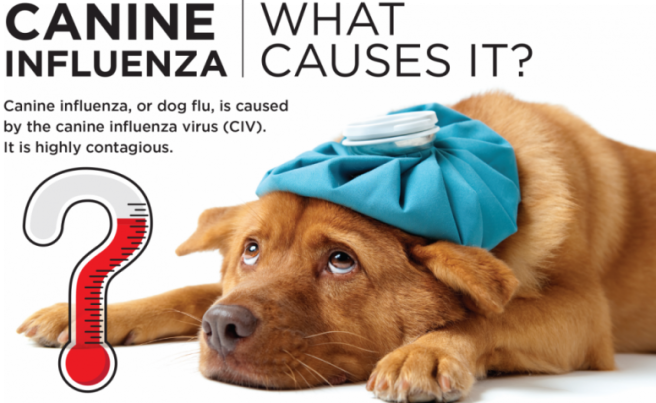We at Ohana Animal Hospital have recently been getting many questions about the canine influenza virus, and I thought this a good topic for discussion. There have recently been a few confirmed cases of canine influenza with the H3N2 virus in the South Bay (2-3 cases confirmed), and this has a lot of people panicked. I know how scary it can be when we use Dr. Google for medical advice (Don’t pretend like you don’t do it –we vets use the same source when trying to diagnose ourselves), and so I am going to try to save you from the impending panic attack inducing web search. I am going to attempt to break down what we know about the canine influenza virus, how it is spread, how it presents (what you will see at home), how it is treated, and what we can do to prevent this in our local Livermore pets.

Let’s start out by going over what we know about the virus. The infection is the result of one of two influenza A virus subtypes: H3N8 and H3N2. The H3N8 form was first identified in Florida in 2004. This strain is very close to the strain that causes equine influenza, and it is thought that the virus mutated to cause the canine strain. The newer (currently in the news) strain is H3N2. H3N2 was first identified in dogs in 2007 in Asia (South Korea, China, Thailand), and is believed to be a direct transfer of an avian influenza virus. The H3N2 viral outbreak was first noted in Chicago in 2015, and since that time thousands of dogs have been confirmed positive for H3N2 influenza across the US. 2-3 cases have just recently been confirmed in the South Bay.
Now that we know what the virus is, let’s talk about how it is spread. This virus is generally spread through aerosolized viral particles (coughing dogs), fomites (the virus being present on inanimate objects that have been exposed to an infected dog), and direct contact with an infected dog. It appears that dogs can shed the H3N8 viral particles for about 10 days after infection, and up to 24 days for H3N2. The worst part about viral shedding is that it often begins before your pet shows any signs of disease, which often results in other dogs being exposed before you know to keep your dog at home.
Now we can talk about how you might know that your dog has canine influenza. Well, it presents very similarly to other respiratory diseases, and many dogs do not even show clinical signs when infected. There are generally 2 recognized patterns of disease in infected dogs. There is the mild form of disease (which is by far the most common), where the disease is very mild and self-limiting (no treatment necessary). These dogs may present to the hospital with a cough (can be wet or dry), lethargy, have a decreased appetite, and may even have a very mild fever. Occasionally these dogs will develop a thick nasal discharge, and that is most often the result of a secondary bacterial infection. There is a much less common severe form of disease, which often times presents with a high fever (104-106F), and signs more consistent with pneumonia (increased breathing effort and respiratory rate).
I know, now you are really freaking out and really just want to get to the treatment section. So, the majority of these dogs do not need any treatment at all, and they will recover on their own (remember, many of these dogs show no clinical signs at all). Some dogs do come to the hospital very ill though, and those dogs do often times require some therapy. Therapy is generally directed act supporting the patient while the virus runs its course. If your dog is very ill it will likely need intravenous fluids to ensure that it stays hydrated. Many of the dogs acting ill have secondary bacterial infections, and intravenous antibiotics can be very important as well. In very severe cases where there is severe lung disease a dog may need oxygen therapy in an oxygen cage while initially being treated also, but this is not common. Once again, most dogs do not require therapy, but if you think your dog may have this disease make sure you have it looked at so we can decide the best course of therapy.

How can we prevent this from spreading in our community?? Any animal that is a suspect canine influenza case should be isolated from other dogs. Obviously this is impossible if your dog is acting completely normal and shedding the disease, but if your dog has a cough it is important to keep him/her at home. Most cases of coughing are NOT canine influenza, but many causes are still contagious,and it’s best to stay at home until the coughing is done. There is a vaccination for canine influenza, and it is something that many people are now looking for. These vaccinations are currently labeled for use in dogs only, and they require an initial dose followed by a booster in 2-4 weeks, and then yearly vaccination thereafter. The vaccination does not prevent infection, but it may help reduce signs if contracted, and may also reduce viral shedding. At this time I am not yet recommending that every dog get this vaccination, as the disease is not very prevalent in our Livermore area (there are no confirmed cases at this time). We at Ohana Animal Hospital are monitoring the situation very closely though, and if we at any time feel it is important for you to have this vaccination we will make a Facebook and email announcement.
I hope this helps a bit with the questions I know many of you have. Please feel free to get in touch with us if you have other questions about the canine influenza virus. Much of the information in this blog post was collected from the AVMA website (canine influenza FAQ page), and a Clinicians Brief article on Canine Influenza if you want more in-depth information. Please feel free to contact Ohana Animal Hospital or Dr. Steffes anytime with questions or concerns, and know we are always here to help any way we can.
